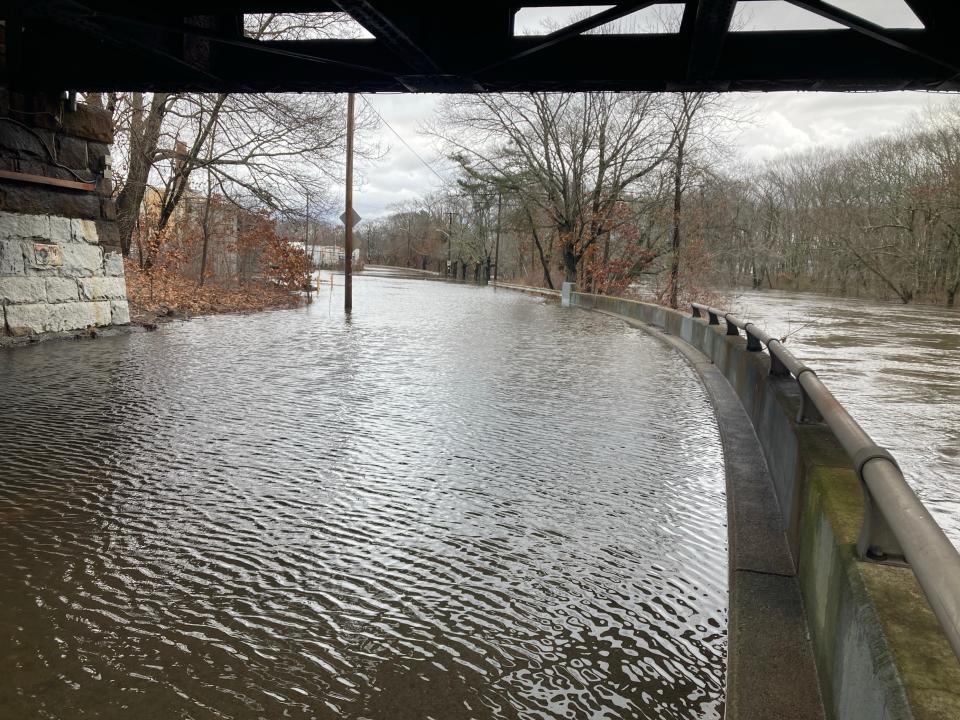Back-to-back major winter rainstorms are 'very uncommon.' What if it was snow instead?
For the second time in a month, a winter rainstorm pummeled Rhode Island, causing rivers to flood over their banks, closing businesses and forcing residents to be evacuated from their homes.
Expensive and hazardous, it's enough to have people wishing for a blizzard, as Jamie Walsh, the general manager at Apponaug Brewing Company did after the Pawtuxet River flooded the first time after the Dec. 18 storm.
"It should have been snow and shoveling, and not sumping out water everywhere," Walsh said.
This raises the question – what would the storm this week have looked like if it was snow?
How much rain did RI get in Jan. 9-10 rainstorm?
First, some stats. The storm dropped 3 to 4 inches of rain across the state, according to Alan Dunham, a meteorologist with National Weather Service (NWS) Boston. That rain fell on top of the 2 to 8-inch snowfall from this past weekend, which melted in the rain,, adding "at least another inch" of water to the total amount of water draining toward the rivers.
The Pawtuxet River is expected to rise to 15.7 feet by midnight on Wednesday, which is considered a major flood, according to NWS. That's higher than the December floods that crested at 15.11 feet, which was the second highest on record after the floods in March 2010. The Blackstone River is expected to rise to 13.9 feet, according to NWS, which is considered a moderate flood.
What would that look like if it was snow?

"If it was 15 or 20 degrees colder, we would have had a whole heck of a lot of snow," Dunham said.
How much snow equals "a heck of a lot" is hard to pin down. The general ratio, he said, is 10 inches of snow to 1 inch of rain. But, warmer temperatures are capable of holding more moisture in the atmosphere, meaning if it was cold enough for snow there likely not would have been enough moisture to create 30 to 40 inches, Dunham said.
While unable to predict an inch count, Dunham said it would have been heavy, wet snow and "much worse" than the Blizzard of '78."
Is it unusual to have rainstorms capable of causing flooding in winter?
This sort of weather is "not what you would typically get in January, but not outside of the realm of possibility," Dunham said.
The previous record rainfall for Jan. 9 was 2.06 inches in 1953, according to Dunham. The record snowfall was 5.8 inches in 1974.
What that means: Catastrophic September floods declared a federal disaster
But to get two major rainfalls back to back like this is "very uncommon" bordering on "unheard of," David Boutt, a professor of earth, geographic and climate sciences at the University of Massachusetts Amherst said.
"It's definitely tied to our warming atmosphere," Boutt said. "It's climate change 101. A warmer atmosphere can hold more moisture and then it can release that moisture quickly, and that's kind of what we saw in this event."
What does this mean in a world with less snow?
A study published in Nature on Wednesday found the whole northern hemisphere is seeing a steep drop in snow because of human influence. In New England, snow plays a key part in winter hydrology, holding water in storage and then slowly melting in spring, gently infiltrating the soil and then the groundwater.
Now, the water is moving through different pathways, such as flooding. It also appears to be mobilizing contaminants out of the ground, Boutt said.
Flooded out: Almost no one impacted by the September flooding disaster had flood insurance. Here's why.
There is "a lot of active research" including upcoming grants from the United States Geological Survey, to look into these changes, Boutt said. While the impacts are still an active research question, changes are becoming apparent.
"We're becoming more sensitive to these year-to-year hydrological changes," he said. "And we're losing the buffering capacity to handle these events."
This article originally appeared on The Providence Journal: January rainstorm floods RI. What if it had been snow instead?

